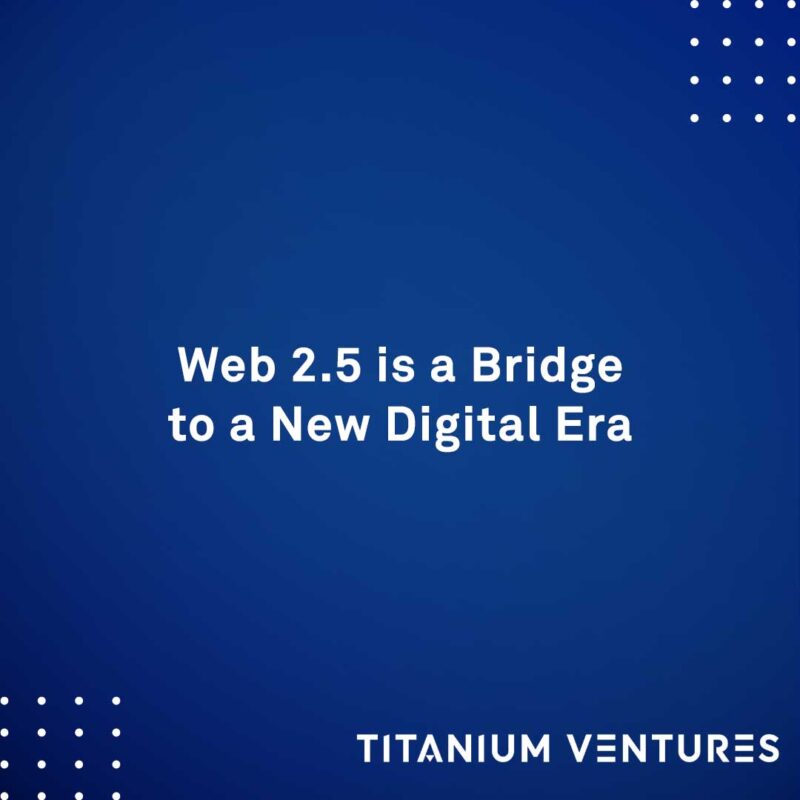For example, it’s easy to overlook the ways revolutionary technologies like blockchain are already being seamlessly integrated into our lives. This process is increasingly being described as Web 2.5 – a market that’s much larger than Web 3.0 at present, and which is creating a bridge from Web 2.0 to a new digital era. There are millions of consumers who don’t realize that they’re engaging with blockchain technology on a regular basis, and this is a sign that the sector is in a phase of rapid growth.
The creation of blockchain-based applications and experiences (whether the end users know about the technology or not) that add real utility and entertainment is a major opportunity for companies, consumers, and investors alike. Much of Web 3.0 still has a high barrier to entry for regular consumers, and this has led to the rapid emergence of Web 2.5 as an entry point to several of the most promising technologies in the world.
What is Web 2.5?
While there’s no universally accepted definition of Web 2.5, the best way to think about it is the use of blockchain technology in a frictionless and user-friendly way. Many consumers want Web 3.0 experiences, but they don’t want to deal with intimidating security protocols, excessive KYC, setting up a crypto wallet (cold wallets, hot wallets, custodians), and other cumbersome elements of Web 3.0 engagement.
Gartner forecasts that the business value generated by blockchain will grow to $3.1 trillion by 2030. Web 2.5 is an indispensable stage of this process, as it mainstreams the use of blockchain in an authentic way that consumers are used to in the Web 2.0 world and makes the technology a more significant part of companies’ daily operations. As of late 2022, there were roughly 2.5 million daily active user (DAU) wallets across Web 3.0 – a proportion that has likely declined in recent months. There are far more daily active users of Web 2.5, and this number is likely to surge in the immediate future.
Despite all the alarmism around the industry at the moment, blockchain isn’t going anywhere. At a time when many investors are playing it safe, Web 2.5 offers an opportunity to get behind several of the most significant technologies on the market in ways that are already providing clear value to companies and users.
The benefits of Web 2.5 for companies and consumers
Web 2.5 has a broad range of applications for brands, especially when it comes to innovative forms of consumer engagement. For example, some brands are distributing blockchain-based NFTs to reward customers with discounts and other benefits. Customers don’t have to set up wallets themselves or buy tokens, as the brand takes care of all this back-end work and offers a pure, unencumbered user experience.
With regular money, customers can receive digital assets that are easily transferable to fiat systems. The blockchain provides a more immersive, gamified loyalty experience which offers the benefits of Web 3.0 without the complexity or inconvenience. Loyalty NFT holders can also receive early access to new releases, exclusive products and experiences, and other benefits – all of which are being adopted across many industries. Blockchain use cases will continue to evolve, and companies are increasingly comfortable deploying the technology for a wide range of purposes.
While some companies will handle blockchain-based services internally, others will work with third parties to develop solutions and integrate them with existing systems. This creates an opening for founders and investors to facilitate the transition to blockchain among established companies and position themselves to take full advantage of a rapidly growing field. The volatility of crypto prices is unrelated to the underlying promise of blockchain technology and other Web 3.0 technologies, and Web 2.5 is the thread that will connect many companies to the future.
Web 2.5 is already changing the face of B2C
There are countless ways in which Web 2.5 has already demonstrated proof of concept. From brand-specific NFTs to new forms of real-world value storage and trading to the creation of immersive digital communities, Web 2.5 enables consumers to interact with their favorite companies (and each other) in completely novel ways.
For example, Starbucks Odyssey will allow users to play interactive games and collect NFTs without a crypto wallet or cryptocurrency, and their ownership (which unlocks experiences and other benefits) will be stored on the blockchain. Shopify is now offering “token-gated commerce,” which will bring NFT communities together with brands that use the platform. These brands can mint custom NFTs and sell them in their own online stores, provide special collections and exclusive drops for token holders, and partner with other companies. StockX is blending the digital and physical worlds with “Vault NFTs,” which provide NFTs that correspond to real items. This allows users to collect and trade without the hassle of packaging, storing, and shipping, and if they ever want the item itself, StockX will send it. Even seemingly risk-averse government agencies such as the California Department of Motor Vehicles are leveraging blockchain technology to move all of its registered automobile titles to the chain
These are just a few of the ways Web 2.5 is fundamentally altering B2C relationships and allowing consumers to keep one foot in the Web 3.0 universe and the other in the more traditional world of commerce. Considering the scale of Web 2.5 and its integral role in moving us toward a new era of digital relationships, transparency, and ownership, companies and investors will increasingly be watching the space in 2023 and beyond.
